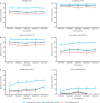Rising incidence rates and unaltered survival rates for primary upper urinary tract urothelial carcinoma: a Dutch population-based study from 1993 to 2017
- PMID: 33690922
- PMCID: PMC8453942
- DOI: 10.1111/bju.15389
Rising incidence rates and unaltered survival rates for primary upper urinary tract urothelial carcinoma: a Dutch population-based study from 1993 to 2017
Abstract
Aim: To assess trends in the incidence, disease management and survival rates for upper urinary tract urothelial carcinoma (UTUC) in the Netherlands.
Materials and methods: Patients diagnosed with primary UTUC in the Netherlands between 1993 and 2017 were identified through the population-based Netherlands Cancer Registry (NCR). Patient and tumour characteristics, as well as information on treatment and vital status, were retrieved from the NCR. Age-standardized incidence rates were calculated, stratified by age, gender, calendar period and disease stage. Relative survival served as an approximation for cancer-specific survival.
Results: We identified 13 314 patients with primary UTUC. The age-standardized incidence rate increased from 2.0 in 1993 to 3.2 per 100 000 person-years in 2017, without change in gender distribution. The increase in incidence held for all disease stages except organ-confined (T1-T2) disease. The most prominent increase was in superficial (Tis/Ta) and metastatic (M+) UTUC, which increased from 0.6 to 1.2 and 0.1 to 0.4 per 100 000 person-years, respectively. The 5-year relative survival did not change over time: 57.0% (95% confidence interval 55.9-58.1). Applied treatments were largely the same over the study period, although fewer radical nephroureterectomies and more kidney-sparing surgeries were performed in the most recent years. The use of peri-operative intravesical chemotherapy modestly increased.
Conclusion: Between 1993 and 2017, the age-standardized incidence of primary UTUC in the Netherlands has increased by more than 50%, but the relative survival of UTUC patients remained unchanged. Preventive measures against exposure to risk factors, early detection of disease, and more efficacious treatment methods are needed to improve outcomes of patients with UTUC.
Keywords: #uroonc; #utuc; epidemiology; incidence; survival; treatment; upper urinary tract; urothelial carcinoma.
© 2021 The Authors BJU International published by John Wiley & Sons Ltd on behalf of BJU International.
Conflict of interest statement
J. L. Boormans reports consultancy work for MSD, Janssen, Ambu and Ismar Health Care, during the conduct of the study, and received a research grant from Decipher Biosciences. All other authors report no conflict of interest.
Figures




References
-
- Roupret M, Babjuk M, Burger Met al.European Association of Urology guidelines on upper urinary tract urothelial carcinoma: 2020 update. Eur Urol 2021; 79: 62–79 - PubMed
-
- Colin P, Koenig P, Ouzzane Aet al.Environmental factors involved in carcinogenesis of urothelial cell carcinomas of the upper urinary tract. BJU Int 2009; 104: 1436–40 - PubMed
-
- Roupret M, Yates DR, Comperat E, Cussenot O. Upper urinary tract urothelial cell carcinomas and other urological malignancies involved in the hereditary nonpolyposis colorectal cancer (lynch syndrome) tumor spectrum. Eur Urol 2008; 54: 1226–36 - PubMed
-
- Cowan NC. CT urography for hematuria. Nat Rev Urol 2012; 9: 218–26 - PubMed
-
- Inman BA, Tran VT, Fradet Y, Lacombe L. Carcinoma of the upper urinary tract: predictors of survival and competing causes of mortality. Cancer 2009; 115: 2853–62 - PubMed
MeSH terms
LinkOut - more resources
Full Text Sources
Other Literature Sources
Medical

